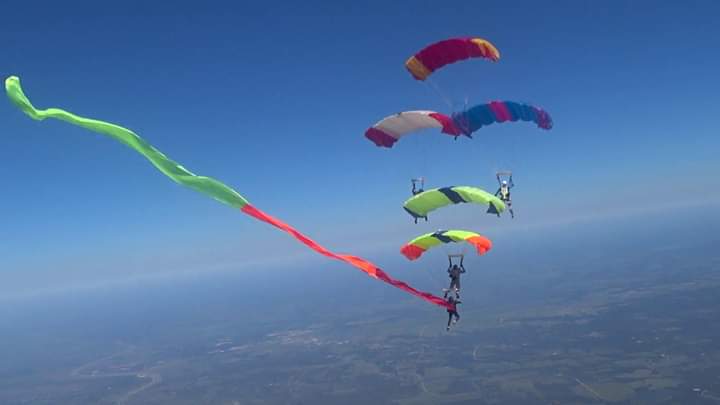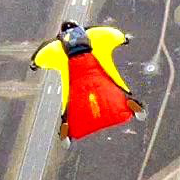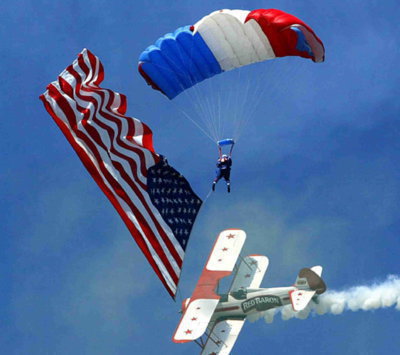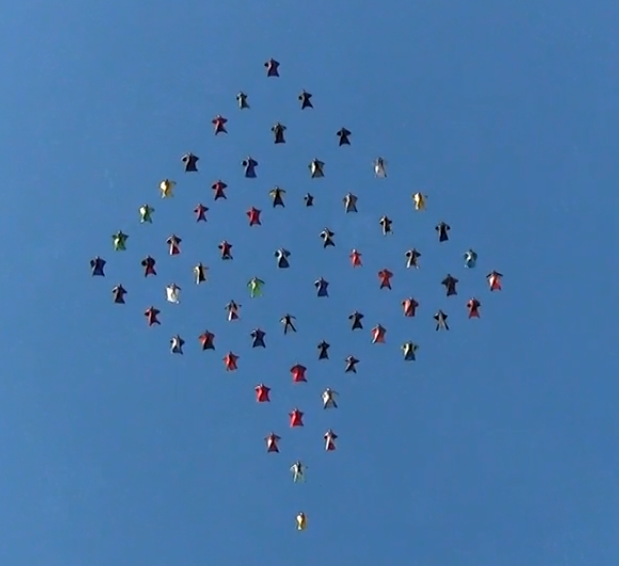Recommended Posts
QuoteThere are some people that think just because they can get 4 people out a C182 at 9000 ft and they all land in the DZ they can spot.
First of all its high time to take spotting in 2 parts: planning and executing.
I think executing is quite the same in every case: check the position and vector of the plane and recognize the right spot to start jumping.
Planing can be simple if jumping with a C182 or complex like a big jumpship.
You can expect skills if those are practiced regularly.
Spotting is a duty of that person choosen by the manifest in our club. He/she usually is choosen, because he/she is the most experienced in that load.
QuoteWhat théy are really doing is making a very rough guess at where to get out of the aircraft.
Why? Spot is not a single point, but an area that you have a really high probability to get back to the choosen landing area even under reserve, shape and position is depending on the winds.
speedy 0
That is better than trying to collect the neccessary information on the climb to altitude, having a pilot that does not know where he is, then looking out of the door and saying "I think we'll get back, lets jump."
Fallschirmsport Marl
QuoteThat is better than trying to collect the neccessary information on the climb to altitude, having a pilot that does not know where he is, then looking out of the door and saying "I think we'll get back, lets jump."
I don't think that everone is boarding the plane without any knowledge of the winds.
Or if we don't have info about winds we throw a streamer on climbing at 600m over the landing area.
I know there are more interesing situations like operation on flied A and plane has to be on flied B about 50kms away .... so lets jump there...no streamer...stop from something....
I have not been in these kind of loads, but I had chance to be there. I said no, because other reasons.
wmw999 2,447
I started jumping when most people had rounds. We had Otters in Houston, and we managed to put all of the people on the DZ, spotting. I.e. looking down, giving corrections to the pilot, and getting out at the right time. Sometimes there were go-arounds for multiple groups (all groups were belly fliers or AFF). But not that many people had thousands of jumps.QuoteYou are living in a dream world if you expect skydivers with a few hundred jumps to be able to ...
1) look out of an aircraft at 14000ft and determine what their freefall drift will be when falling
2) what the winds are at opening altitude.
3) where they are to the nearest 0.5 of a mile from the DZ
4) know the direction the plane is flying to within 30°
5) and finally have any idea how much ground speed the plane has to within a 20 kt margin of error.
Spotting is important, and a GPS will tell you exactly where you are. But a GPS is not essential. Looking outside is essential, particularly if a wind streamer hasn't been thrown in the morning.
How many times have you heard something like "the pilot has been turning in short on jump run all day."
Wendy W.
speedy 0
QuoteLooking outside is essential,
And no where, ever, did I say you should not be looking outside.
Fallschirmsport Marl
speedy 0
QuoteI don't think that everone is boarding the plane without any knowledge of the winds.
When I said
Quote
3) where they are to the nearest 0.5 of a mile from the DZ
4) know the direction the plane is flying to within 30°
5) and finally have any idea how much ground speed the plane has to within a 20 kt margin of error.
Note that ground speed is a pretty good indication of winds at altitude.
Ron said
QuoteThey don't need to know any of that. It does not matter if they are .5 or .6. All that matters is
they know if they can make the DZ. The distance, angle, or ground speed is not needed information.
Only knowing if they can make the DZ.
Now I ask myself, how the fuck can they know if they can make the DZ when they have no knowledge of the winds?
Fallschirmsport Marl
QuoteNote that ground speed is a pretty good indication of winds at altitude.
For your level of experience, but for mine.
Anyway it can be an indication of winds on exit level. I've seen wind direction difference more than 90 degrees in different layers of air,
QuoteNote that ground speed is a pretty good indication of winds at altitude
My jump numbers arent high , but if I were to go by this, two weeks ago at sebastian, who knows where I would have ended up. The uppers were 100 per the board and ground were 11 ... Id think that most people would be wise to verify the speeds of the winds with other sources if they are available...
Sudsy Fist: but you're looking damn sudsydoable in this
QuoteI suppose you think your eyesight is more accurate than GPS
***
I can get just about as close...here's how, may give some food for thought.
Find out how long the runway is.
Convert that measurement in feet to miles, this gives you a 'key' scale...like on a map in terms of 'inches to miles'.
Either ask the pilot, or call flight service and get the winds aloft...now you have an idea as to the freefall drift to expect.
On a sunny day, if I'm spotting I can pretty accurately tell 1/2 way up if there will be clouds at or near the exit point when we get to altitude...
Check your altimeter going through the cloud base and figure out approximately what direction and speed they are moving using the winds aloft numbers...
from the 'time of day' or angle the sun is relative to the horizon, you can figure out how the cloud shadows on the ground relate to the actual position of the clouds making them.
Looking down at the LZ, draw an imaginary jump run line and see if there are any shadows on that line and if so...how many 'runway' lengths 'upwind' are they.
We were doing a demo a couple months ago here in Houston, there was a lot of discussion about staying below the clouds and doing a hop n pop low show, or going high and 'hope' for a hole at the designated jump time. I said go high...in ten minutes there will be a 'hole' right over the LZ...and there was.
Spotting is both art and science, and like any skill, has to be constantly practiced in order to stay sharp.
A GPS is a useful tool, just like an AAD or an Altimeter...but I always rely on my own abilities first.
~ If you choke a Smurf, what color does it turn? ~
QuoteBTW sorrry about the BS here...I don't know why some just have to argue, and I don't know why I bother trying to debate those folks.
As you should be. Who do you think you are trying to disseminate good safety information. You should be ashamed of yourself trying to help skydivers live to jump another day.
I would be very curious how many participants of this thread could, given an aerial map of a strange drop zone, runway length, a winds aloft report, the air velocity (speed & direction) of the plane on jump run, and a round parachute could spot themselves and land in their intended landing area.
My guess is without that pretty green light, quite a few would have a long walk back to the packing hangar.
For Great Deals on Gear
QuoteI have tried to teach people how to spot and unless you stay with Rons "look out of the door and guess" their eyes glaze over. They don't want to know about freefall drift, wind speeds and direction, wind shear, forward throw, etc.
I must have missed where Ron said "look out the door and guess." Could you please link to that post?
For Great Deals on Gear
speedy 0
Quotegiven an aerial map of a strange drop zone, runway length, a winds aloft report, the air velocity (speed & direction) of the plane on jump run,
Which is all good stuff.
Ron says (Post #75 )
QuoteThey don't need to know any of that. It does not matter if they are .5 or .6. All that matters is
they know if they can make the DZ. The distance, angle, or ground speed is not needed information.
Only knowing if they can make the DZ.
That to me is looking out of the door and guessing.
But no one reads anything posted here really
Fallschirmsport Marl
kallend 2,027
QuoteBut I ALSO have a pilots license.

Your willingness to trust everything but you is AMAZING! A real testament to device dependancy.
I take it you do not fly much IFR.
The only sure way to survive a canopy collision is not to have one.
__________________________________________________
I think I am in a minority because I am interested in that information. I actually want to learn how to do this and do it well. Equipment does fail and you can't rely soley on it. Early on under canopy, I made myself learn how to tell if I was going up or downwind without looking at the windsock. That served me well when I had my first off-landing and couldn't see the windsock. I still landed right on the windline. Of course I still look at the windsock, but I know I'm not totally dependant on it. That's how I would like to eventually be with spotting skills. I want the satisfaction of knowing I CAN do it...and of course it could save my life.
All things work together for good to them that love God...Romans 8:28
speedy 0
QuoteI think I am in a minority because I am interested in that information.
Excellent! Keep up the practice and interest.
QuoteI actually want to learn how to do this and do it well
Great! Here is a link to some stuff from John Kallend Skydiving resources. The "Powerpoint presentation on exit safety with freefall sim" is very interesting. There is something about spotting in there as well. Don't forget to talk to your instructors about what you read just incase you misunderstand any of it.
QuoteThat served me well when I had my first off-landing and couldn't see the windsock.
Glad to see you are heads up about landing your canopy. Why did you land off though? Wansn't a spotting error I hope
Fallschirmsport Marl
__________________________________________________
It was actually pretty funny. The spot was great...the jm put me directly over the airport because we all got out at 4200. I did not pull stable so had to deal with line twists, by the time I found the dz, I was too far to the right to make it back. No big deal, I just picked a nice big field full of cows to land in. I loved how they all stared at me when I landed
All things work together for good to them that love God...Romans 8:28









What théy are really doing is making a very rough guess at where to get out of the aircraft.
When you need to get 20 people in multiple groups out of an otter at 14000 ft with the correct exit seperation then I am going to use all the tools I can to make sure all 20 get back to the landing area. If that means using GPS to start the jump run at 0.5 mile before the DZ then so be it. I know that if I let the majority of jumpers decide when they exit, we would have a fuckup at least every other load.
I have tried to teach people how to spot and unless you stay with Rons "look out of the door and guess" their eyes glaze over. They don't want to know about freefall drift, wind speeds and direction, wind shear, forward throw, etc.
And your pilot has no clue how to find the DZ?
Here is some interesting information for you. I can only direct our pilots during the last 2 miles of run in to the DZ. Otherwise I cannot tell the pilot where to fly. ATC tells the pilot where to fly and if he does not follow their orders he's in big trouble. Do you not think it would be wise for me to tell the pilot which direction I would like to run in before we are at altitude?
Fallschirmsport Marl
Share this post
Link to post
Share on other sites